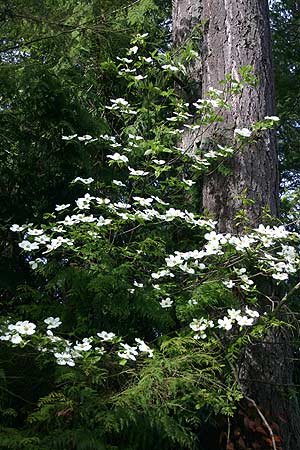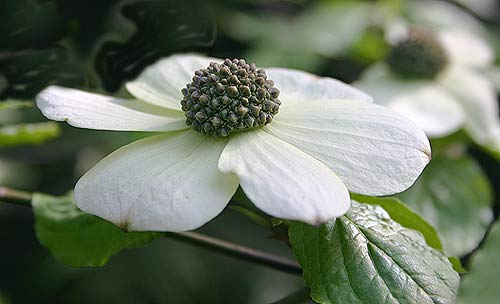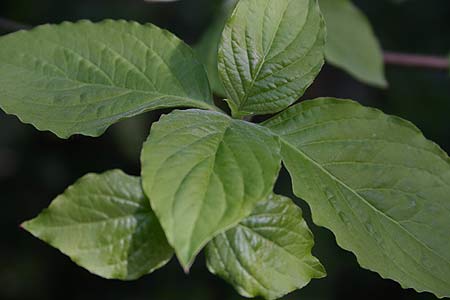Cornus nuttallii
PACIFIC DOGWOOD, MOUNTAIN DOGWOOD, MOUNTAIN FLOWERING DOGWOOD
Family: Cornaceae
Pronounced: KOR-nus nuh-TALL-ee-eye
Quick Jumps
Growing Guide
Rainy Side Notes
GROWING GUIDE

Origin:
Washington, Oregon, British Columbia, Northern California and Idaho.
Plant Group:
Deciduous tree.
Hardiness:
Sunset zones: 3b-9,13-20.
USDA zones: 7-8.
Mature size:
Height: 40 feet (12 m).
Width: 25 feet (8 m).
Flowering period:
Spring and occasionally repeating again in early fall.
Flowering attributes:
Greenish flowers, tipped with purple, grow in tight clusters surrounded by six large, showy, white bracts. The number of bracts varies; there can be as little as four or as many as seven surrounding the flowers. Clusters of bright red, drupe-shaped, half-inch long berries follow the flowers and ripen in October.
Leaf attributes:
Elliptical, sharp-pointed at the tip, tapered at the base, slightly wavy margins, deciduous, green leaves that turn a pinkish-red in autumn.
Light:
Full sun to part shade.
Soil:
Moist, humus rich, deep, well-drained soil.
Propagation Methods:
Sow seeds when ripe in autumn and place in a cold frame. Stored seeds will need stratification.
Layer in June to July. It takes 9 months to strike roots. | Cuttings in early summer.
Pruning Methods:
Does best with minimal pruning. Prune only to remove crossing or wayward branches to maintain a healthy framework.
Pests and Diseases:
Dogwood anthracnose is a serious problem for Pacific dogwoods.
Rainy Side Notes

When I discovered a Cornus nuttallii in bloom many years ago, I deduced that someone had purposely planted it in the middle of nowhere. It looked like an exotic tree belonging in a botanical garden, not a native that grew at the edge of pristine woodlands in the Pacific Northwest. Finding out this exotic looking tree was a native to my own nativity was exciting.

In spring, when they come into bloom, their snow-white bracts beckon me to slow down and take in their elegant beauty, a highlight of the season. On the edge of the forest, Pacific dogwoods grow splendidly, rubbing shoulders with many conifers, such as western hemlocks ( Tsuga heterophylla), western red cedar ( Thuja plicata), spruce ( Picea sitchensis), Ponderosa pine ( Pinus ponderosa), and Douglas fir ( Pseudotsuga menziesii). At its feet grow other natives—rhododendron ( Rhododendron macrophyllum), ocean spray ( Holodiscus discolor), Pacific bayberry ( Myrica californica), snowberry ( Symphoricarpos albus), and Pacific yew ( Taxus brevifolia). All of these natives shade the dogwoods' trunks, preventing sun damage. While the dogwood can grow in the full shade of a conifer forest, it won't flower as well, if at all, and grows lanky.
Successfully growing a Cornus nuttallii as a multi-branched, specimen tree in the garden takes some precautions. Shading the trunk from sun with no extra watering during our drought season is important to insure its garden success. Although during severe drought watering might be called for, use a soaker hose, not an overhead sprinkler. Give the dogwood a similar habitat to where it grows naturally to support its flourishing.
Unfortunately, our native dogwoods are dying from dogwood anthracnose, a nonnative fungal disease caused by Discula spp, that slowly kills the tree, limb by limb. It's uncertain whether the disease was imported or if it was a benign fungus that mutated into a killing one. It's imperative we grow them in a way that prevents the disease from taking hold. Pacific dogwood needs excellent drainage, deep, humus rich soil, not too much summer watering, minimum to no pruning and shade on its trunk to avoid sunscald. Keeping the tree stress free is the best prevention for this disease.
David Douglas first discovered Cornus nuttallii, but thought it was an Eastern native, Cornus florida. Scientist Thomas Nuttall looked at it and realized it was a new species. Later, John James Audubon named the species in Nuttall's honor.
Besides growing in the Pacific Northwest, Pacific dogwood is found in the mountains near San Diego and Los Angeles, and a small population grows in Northern Idaho, where it is threatened. The flower is the floral emblem of British Columbia.
Because of its tannin, the bark is used for a rich, brown dye and as a preservative. The slim, long branches are made into baskets. Close grained and extremely hard wood, make it useful when made into tool handles, as well as for cabinetry.
For indigenous people, the wood was important; they used it to make bows, arrows, tool handles and hooks. Medicinally, it was used as a blood purifier, for strengthening lungs, and help with stomach ailments.
Photographed near Indianola, Washington.

Gardening for the Homebrewer: Grow and Process Plants for Making Beer, Wine, Gruit, Cider, Perry, and More
By co-authors Debbie Teashon (Rainy Side Gardeners) and Wendy Tweton
Copyright Notice | Home | Search | Natives

